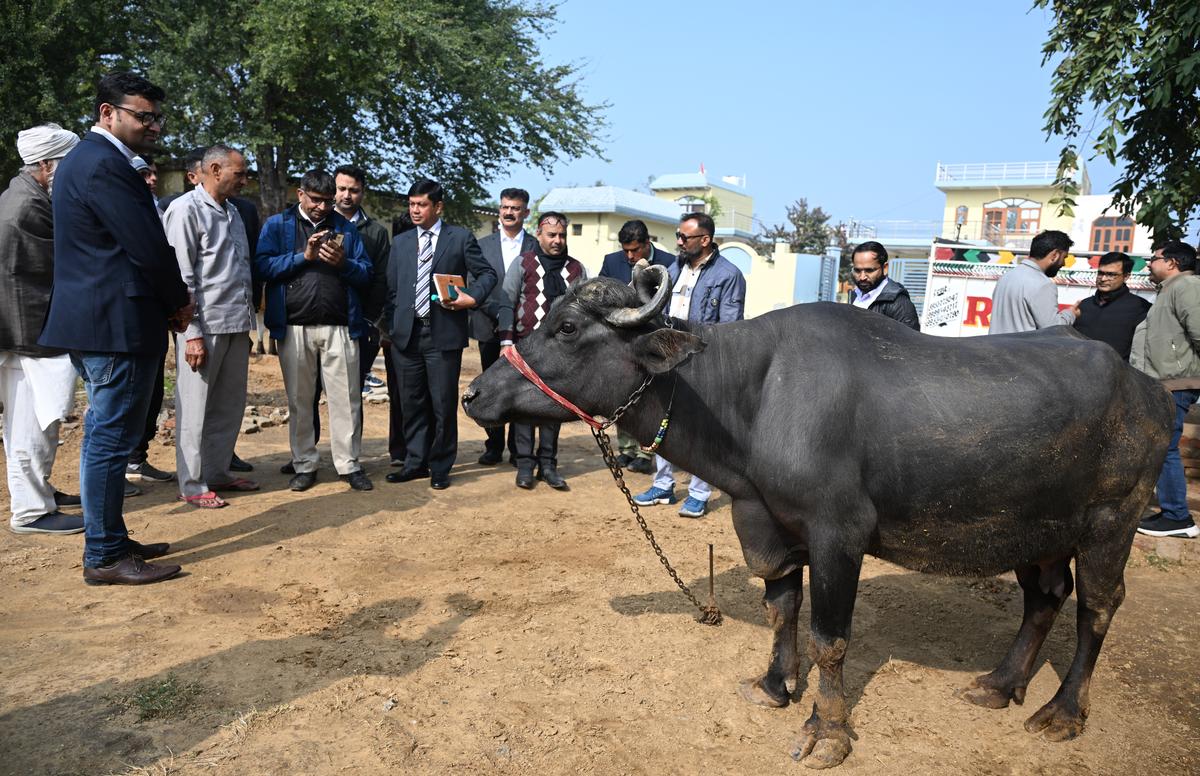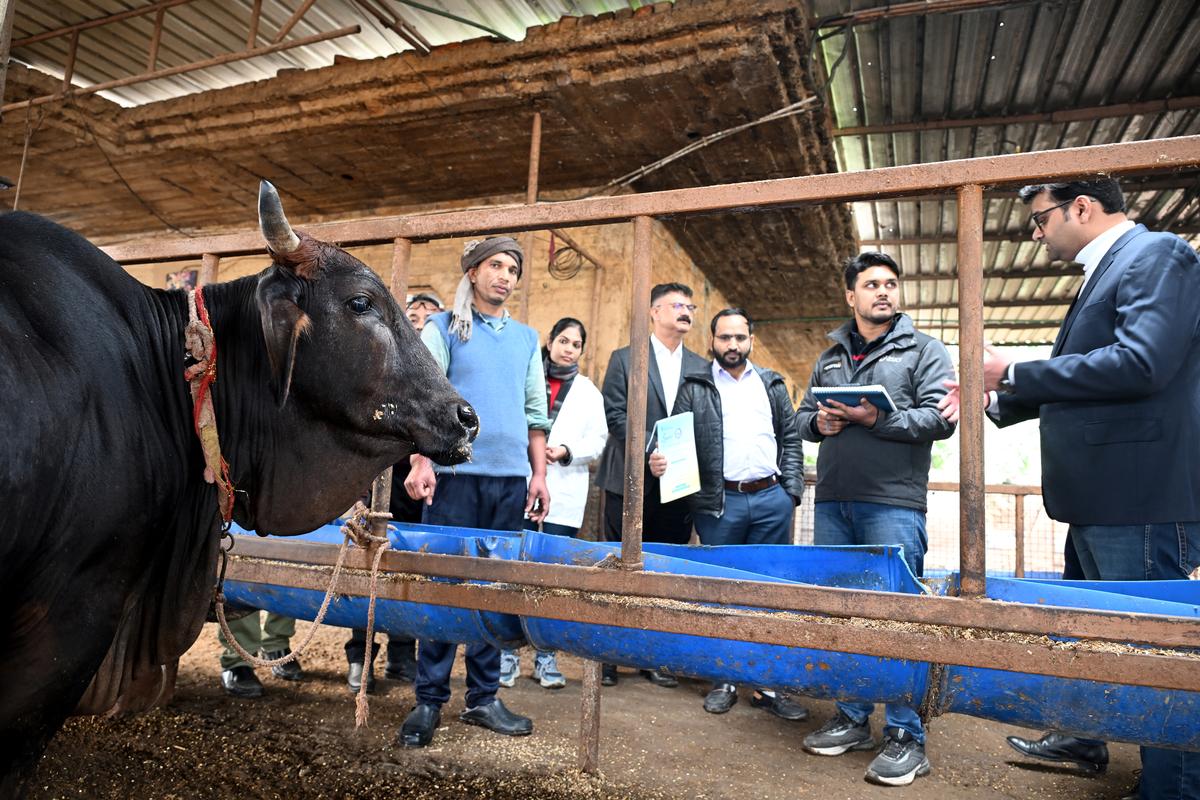VIJERD and NARENDAR, both 60 years old, both neighbors in Kanware Village on the outskirts of Faridabad in Haryana, had great hope when a team of officials visited their village as part of the current 21 cattle census. They believe that once counted, the number of milking animals in their locality will force the government or a private entrepreneur to start a dairy or a milk collection center in its locality. “There are no dairy here. If there had been a dairy here, we wouldn’t have to go to Faridabad every morning to sell milk, ”says Narender.
Vijander has only a buffalo, but Narender has two cows and a buffalo. “I have been growing cattle for 40 years. The lump skin disease had affected our village in 2022. Then the doctors had come. We understand that, according to this census, we will obtain more information on cattle breeding, ”says VIjander, and adds that information such as the correct medicine dose for animals is a challenge for them. “We hope to obtain adequate information after this census.”
The duo also expects the subsidy for a buffalo, which costs ₹ 1.5 Lakh now, increases from the current figure of ₹ 70,000. LAL LAL, 50, the enumerator in his town, comforts farmers saying that there are about 400 cattle in his town and that the government will surely help them.
The 21st Livestock Census of India will have 16 species: cattle, buffalo, sheep, goats, horses, donkeys, camels, pigs, dogs, chicken, ducks, geese and yaks) and their 219 races. Started in October 2024, central government officials expect the survey results to be presented in July 2025. The census will cost ₹ 419 million rupees and has approximately 1 Lakh enumerators such as LAL LAL and 17,000 supervisors deployed throughout the country . The last human census took place in 2011.
When the minister of the Union for Animal Breeding and Dairy, Rajiv Ranjan Singh, launched the survey, said he would play a key role in the configuration of policies that would guarantee the sustainable growth of the won sector of India. He recognized the sectors as a significant source of nutrition, employment and income for millions of homes. “The 21st livestock census will give us updated data on the livestock population, which will allow the government to address key issues such as disease control, improvement of rural race and livelihoods,” he said.
The outbreak of lumpy skin disease in 2022 had claimed the lives of thousands of cattle in the country. | Photo credit: Sushil Kumar Verma
More than 2.1 million people in India are dedicated to cattle agriculture. The twentieth cattle census had thrown disturbing trends. The camel population was reduced to 2.5 Lakh, at a 37.1% decrease five years before. Similarly, the number of pigs decreased by 12.03% and the number of horses and ponies decreased by 45.2%. The donkeys saw a 61.2% decrease and the mules fell by 57.1%. However, Corral birds had increased by 16.08%.
This time, the center awaits an increase in figures, since farmers after COVID-19 have been investing in animals. Authorities say this is for several reasons, including loss of employment during blocking and reverse migration. However, the lumpy skin disease that hit the country three years ago had claimed the lives of thousands of cattle. This will also be reflected in the census.
The data collection process
Kumar Dipak, in its 20 years, is one of these enumerators. He has a diploma in veterinary sciences. At present, cattle and other species in the urban area of Faridabad. “Registration of animals using the 21st application of the cattle census. First we load the details of the home and then the details of the animals labeled and without labeling separately, ”he says, explaining that the animals are being labeled with objective information on race and age, with a unique identity number. The metal label has perforated details in the ears of the animals. Most desire have been labeled so far.
It also uploads details such as Milch or not a thousand, the number of calves and facilities in cattle sheds. “We identify the races with the help of farmers,” says Kumar, and adds that it is an application only for Android. This updated application has more functions than the previous one, with an image load option and a board to verify and verify the data and the option to capture the location.
This is the second time that street animals are being registered. “If I see an animal outside a home, I first consider with the villagers if they have an owner. If they do not, we consider them street. We upload an image and mention the genre too, ”he says. Local organizations and farmers are also consulted on street dogs.
After surveying 60,000 homes in Faridabad, the population of street dogs is approximately 8% of the human population. Street cattle is a big problem in Faridabad and its surroundings, particularly worrying for farmers, whose crops become food.
The district has 11 registered GaushalaS for which the Haryana government provides subsidies (for fodder and construction shelters). There are not registered GaushalaS Also, run in private. “All animals in GaushalaS are mandatory, ”says veterinarian Dr. Virender Sehrawat, deputy director, animal breeding, Faridabad.
Jagat Hazarika, advisor (statistics) of the Ministry of the Animal Breeding Union, often travels with the enumerators to evaluate the progress of the census. “At the end of the census, we can say how many households have at least one animal. In that sense, we also count the number of households in the country, ”says Hazarika, while in a farm of cattle near Faridabad, supervising the work.

Jagat Hazarika (left), an advisor to the Ministry of Animal Breeding of the Union, supervises the work. | Photo credit: Sushil Kumar Verma
He says that a unique feature is that “we can also provide details about pastoral communities.” For the first time, they will also register the number of women producing animals. “The enumerators will evaluate the amount of hours that each person spend in a home in this work. Our main evaluation is that more than 70% of the resorting to animals are women, ”says Hazarika.
Dr. Monika Singh, veterinary surgeon, is supervisor, with four enumerators, including Kumar, working under her. “The enumerators have guidelines to continue with the identity breeds. They upload it in the application. Verify 20% of the charged data and delete them. I have 80 villages under me, ”says Dr. Singh.
Women in the Front
Poonam Chaudhary, 29, along with his sister Nelam Chaudhary, 27, has run Poonam Dairy in Ballabgarh near Faridabad during the last nine years. Graduated, she worked with the Uttar Pradesh police force and resigned to concentrate on her buffalo farm. “I started with a buffalo and now we have 12,” he says, and adds that it is still difficult to meet people’s demand for quality milk. He is now trying to make a cow manure gas plant near his farm.
The Chaudharys begin their day at 3.30 am after cleaning the stable, built at approximately 2,700 square feet, feed the buffalo at 4 am, the milking starts at 5 am and continues until 7 am. Both sisters order the buffalo that use their hands as machines do not work in buffalo. People come to their farm at 7 am to buy milk. At night, it is the same process, with its day that ends at 9 pm after preparing the food for the cattle for the next day. Poonam says that his current work is much better, both in terms of tranquility and income. Once the census ends, I hope that the government concentrates more in guaranteeing medical care for animals. Buffalo medications are very expensive, “he says, hoping that there will be some reimbursement.
Milan Sharma, 56, was project manager of one of the educational projects of the German government in India. She also taught German as part of the project. In 2017, his father -in -law died. He had four indigenous cows at home near Faridabad. Milan and her husband Cutan decided to build a farm of indigenous cows in memory of their father -in -law who loved to take care of the Hariyanwi and Sahiwal races, popular in Haryana and Punjab. He started with two Sahiwals and at one point he had more than 250 cows. Now, she says that age is updating and her farm has about 100 cows. “We donate many of our cows to the villagers,” she says.

The census has approximately 1 Lakh enumerators and 17,000 supervisors deployed throughout the country. | Photo credit: Sushil Kumar Verma
Milan, who resigned from his work in Education in March 2018, attended two courses offered by the National Institute of Dairy Research in Karnal, administered by the Indian Council of Agricultural Research. “Within a year and a half, I realized that without integration with agricultural production and processing, this cannot be sustained,” he says, adding that he contacted Haryana’s government to get help. Now, the farm is completely self -sufficient. “We cultivate cereals and oil seeds, all using cow and grout manure of the gas plant manure,” he says, adds that he now performs training for farmers in Haryana. She advocates for greater consciousness that can be generated through training sessions for farmers.
Emerging patterns
While Hazarika speaks, look closely at a cow. He asks Dr. Sehrawat if a particular cow is a Sahiwal, an indigenous race in Haryana and Punjab. Sehrawat clarifies that it is a mixed race and shows him a Sahiwal, known for his prominent hump.
Dr. Sehrawat says: “In Faridabad, we have completed the census in 60,000 homes of 4 Lakh. We have 80 enumerators and 18 supervisors. We are trying to complete the process before March 15 “. The enumerators were trained by the teachers of the Government of the Union.“ In 2019, there were 1.72 LAKH of cattle in Faridabad. We hope that the number will be more or less the same We had 34,000 cows last time.
One of the possible reasons for the increase in the number of livestock is the restriction in trade and killing after the implementation of the Haryana Gauvansh Sanrakshan and Gausamvardhan law, 2015. The law harden further in 2019.
Another pattern that the enumerators are seeing is the erosion of the grasslands in Delhi-NCR, which means that farmers now have to buy fodder. In Faridabad, Dr. Sehrawat says that the number of pet dogs could increase in thousands. “Most of the races held in Houses of Haryana are exotic,” he says.
A doctor who wanted anonymity, says that things are not as soft as the center promised. “The application logs very often. It will not work if there is no solid Internet connection. Therefore, the enumerators often have to load the data in the office or at home where there is a WiFi connection, ”they say.
Published – February 2, 2025 07:56 PM IST










